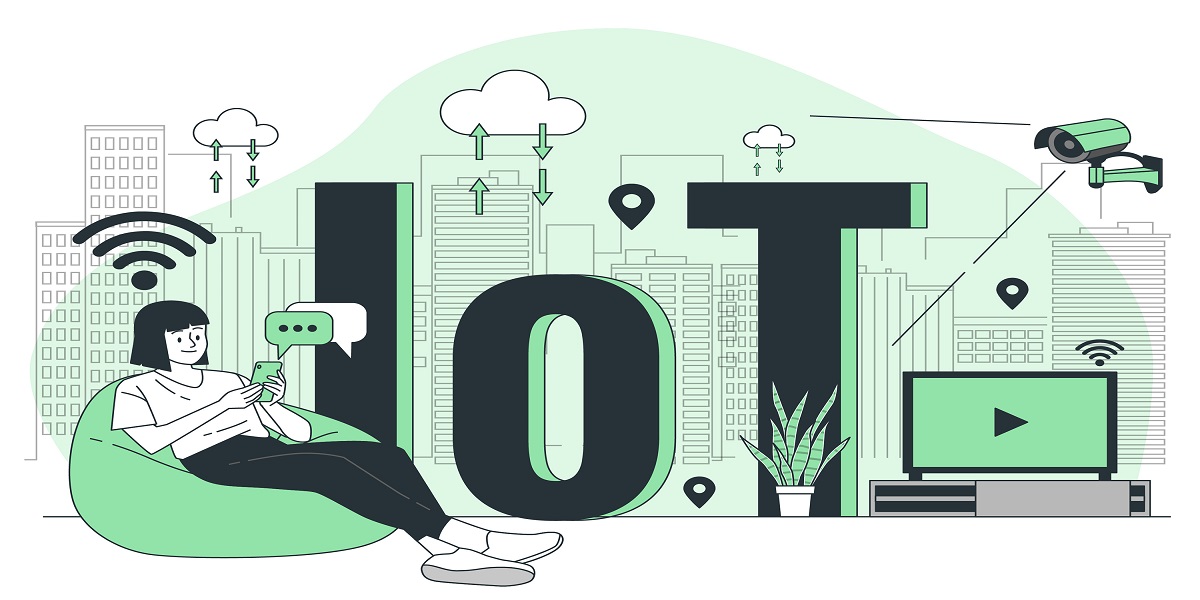
IoT Integration for Real-Time Tracking
- By Yokesh Shankar
- 20-03-2024
- Internet of Things
Supply chain management has become more sophisticated in the dynamic and ever-changing field of logistics. Businesses have to deal with a wide range of issues, such as satisfying consumer requests while protecting their assets and optimising costs and efficiency. But in the middle of this situation, a revolutionary solution has surfaced: the application of Internet of Things (IoT) technology.
The term Internet of Things blockchain traceability software describes how actual things and gadgets are connected to one other over the internet, allowing them to share, gather, and process data. IoT in logistics refers to the continuous collection and transmission of useful real-time data by means of sensors, trackers, and networked devices installed in assets, cars, warehouses, and even parcels. Numerous factors are included in this data, including location, temperature, humidity, shock, and other performance measures.
Businesses may reap a host of advantages that reduce expenses, simplify workflows, and boost overall productivity by incorporating IoT into logistics operations. A few examples of the game-changing benefits IoT brings to the logistics sector are: real-time asset, vehicle, and shipment tracking and monitoring throughout the supply chain; effective inventory management; predictive maintenance; route optimization; increased safety and security; streamlined warehouse operations; improved customer experiences; and data-driven decision-making.
In this article, we will examine the many advantages of integrating IoT in logistics and how it helps companies stay competitive by enabling real-time tracking and monitoring for increased productivity. Now let's get started!
Overview of the Current State of Implementing IoT in Logistics
IoT adoption in logistics is expanding at a really impressive rate right now, and big things are about to happen. The market for IoT in logistics was projected to be valued USD 37.41 billion in 2021 by Market Research Future. With an anticipated value of USD 93.85 billion by 2028, the estimates, however, are even more encouraging. This represents an impressive compound annual growth rate (CAGR) of 14.0% from 2022 to 2028.
These figures demonstrate how the logistics sector is starting to recognize and use IoT technology more and more. Companies are starting to see how revolutionary IoT can be for increasing productivity, streamlining processes, and obtaining a competitive advantage. The market's notable expansion is a symptom of the rising demand for IoT solutions and how they're influencing the logistics industry.
The Benefits of IoT in Logistics
The following are the main benefits that IoT offers the logistics industry:
Benefit 1: Improved Tracking and Visibility in Real Time
More visibility and real-time tracking capabilities are two of the main benefits that IoT offers logistics. Through the integration of Internet of Things devices, such as sensors, RFID tags, and GPS trackers, into different components of supply chains, such as cars, containers, and warehouses, companies may obtain unmatched insight on the whereabouts and state of their assets and shipments.
These Internet of Things (IoT) sensors are always gathering a lot of data, which includes location, motion, temperature, and humidity. This information is sent wirelessly and made available via easily navigable mobile or web applications. Furthermore, real-time tracking enables logistics managers to keep a close eye on the flow of products, quickly spot any delays or disturbances, and make informed decisions promptly.
The Importance of Visibility in Logistics Operations
For logistics operations to be successful, visibility is essential. Businesses may increase productivity and effectiveness by using the precise and current information it provides on their shipments and assets. Here are some main justifications for why visibility matters so much:
Effective Resource Allocation, Precise Delivery Scheduling, and Route Planning are all made possible by real-time visibility for logistics management. They can prevent delays or bottlenecks by anticipating them and taking proactive remedial action to ensure smooth operations.
- Inventory Management: To ensure efficient inventory management, it is essential to have visibility into the location and condition of inventories. It gives companies more control over inventory levels, reducing the likelihood of stockouts and overstocking. They can improve order fulfillment and inventory levels with real-time visibility.
- Customer satisfaction: Businesses may give consumers precise information about the status and expected arrival time of their goods thanks to real-time tracking. This openness strengthens relationships, facilitates better communication, and raises client satisfaction levels overall.
- Risk management: Supply chain visibility enables companies to quickly recognize and resolve possible risks and problems. They may proactively manage risks by rerouting goods during interruptions or guaranteeing regulatory compliance by having real-time knowledge.
That being stated, we are aware that increased visibility and real-time tracking are the main advantages of IoT implementation in logistics. IoT technology may help companies plan more effectively, manage inventories more efficiently, increase customer happiness, and proactively handle risks—all of which can lead to more successful and efficient operations.
Benefit 2: Enhanced Resource Allocation and Route Planning
In order to minimise costs and optimise operational efficiency, logistics companies must prioritise effective resource allocation and route planning. This is the exact situation in which IoT adoption is highly beneficial. Businesses may obtain useful data through IoT, enabling them to make well-informed decisions on resource allocation and route planning.
Making Accurate Decisions Based on Data by Utilising IoT Sensors and Devices
- Data in Real Time: IoT sensors and devices continually gather real-time data on a number of crucial logistics operations factors, including the position of vehicles, traffic patterns, meteorological updates, and the state of the cargo being transported.
- Data Correctness: IoT sensors produce data that is incredibly accurate and dependable. Businesses have a thorough and accurate insight of the logistics environment by getting rid of manual data input mistakes.
- Predictive analytics: IoT devices may use data to anticipate possible route interruptions and precisely estimate delivery times by utilising sophisticated analytics. This enables logistics managers to reduce delays, allocate resources optimally, and deal with problems proactively.
IoT devices offer a comprehensive picture of the supply chain through their seamless integration with other logistics systems, including inventory management and fleet management software. Decision-making and resource allocation are made possible by this integration.
Logistics companies may revolutionise resource allocation and route planning by utilising real-time data and analytics through the use of IoT technologies. This results in more efficient operations, more cost-effectiveness, and a competitive advantage in the ever-changing logistics market.
Benefit 3: Improved Stock Control and Streamlined Inventory Management
The seamless functioning of logistics systems depends on effective inventory management, and IoT offers a ground-breaking way to accomplish this goal. Logistics companies may accomplish real-time inventory tracking using IoT sensors and devices, guaranteeing precise and current data about their inventory levels. IoT device data is effortlessly sent to a centralised database that is available to authorised individuals globally. Businesses can check product movement, keep an eye on inventory levels, and improve supply chain efficiency with this degree of connection.
There are several benefits of integrating IoT into inventory management, such as:
- Enhanced Precision: Logistics companies may reduce the chance of human mistake and improve inventory accuracy by automating processes. The ability to gather and monitor data in real-time data collection and monitoring enables.
- Decreased Labour Costs: The labour expenses related to manual tracking and management are greatly decreased by automating inventory management procedures. Routine inventory procedures are automated by IoT-enabled devices, freeing up resources for more strategic and value-added work.
Data-driven decision-making is made possible by IoT, which gives logistics companies access to real-time inventory level data. Businesses can make well-informed decisions about inventory replenishment, ordering, and overall inventory management strategies when they have fast access to reliable inventory information.
Logistics companies may streamline processes, reduce mistakes, and increase efficiency across their supply chains by utilising the Internet of Things (IoT) for inventory management. Proactive decision-making is made possible by the automation and real-time data that the Internet of Things offers. This ensures optimal stock control and streamlines shipping procedures.
Predictive maintenance and less downtime are the fourth benefit.
The application of predictive maintenance, which reduces downtime, is a major benefit of integrating IoT into logistics. For instance, by utilising IoT devices and sophisticated analytics, firms may collect and examine large amounts of data from their assets and equipment. They are able to anticipate when maintenance is needed, which helps them to optimise maintenance plans, reduce costly unexpected downtime, and prevent equipment breakdowns before they happen.
The Importance of Intervals Decrease in Logistics
In logistics, minimising equipment downtime is crucial for the following reasons:
- Enhanced Productivity: When equipment operates at peak performance and is free from unforeseen malfunctions, logistics activities are conducted more easily and effectively. Higher production and increased productivity are directly correlated with less downtime.
- Cost savings: Unexpected downtime may be quite expensive as it raises maintenance costs, causes revenue loss, and delays delivery. By anticipating possible problems, predictive maintenance helps save the expenses linked to major malfunctions.
- Enhanced Client pleasure: Dependability and prompt delivery are essential for client pleasure. With predictive maintenance, logistics companies may reduce downtime and build enduring connections while meeting client expectations.
- Enhanced Safety: When equipment malfunctions, there are hazards to the environment and to the personnel. By ensuring that equipment stays in ideal condition, predictive maintenance lowers the likelihood of mishaps and possible risks.
Logistics companies can guarantee smooth and dependable service delivery, maximize operating efficiency, and proactively handle repair needs. Adopting this revolutionary strategy improves productivity, customer happiness, and general safety while lowering expenses and downtime.
Benefit 5: Streamlined Cooperation with the Supply Chain
A good supply chain must include cooperation and information exchange among its participants, but this may be difficult to achieve, especially in complicated logistical operations. Nonetheless, the use of IoT technology in logistics has transformed stakeholder coordination and communication by revolutionising teamwork.
Real-time data sharing amongst supply chain participants is made possible by IoT technology, which offers insightful information about the flow of assets and commodities. This real-time data interchange improves supply chain visibility, speeds up and improves decision-making, and spots any problems early. Supply chain partners may access and share the same data at the same time using IoT technology, which promotes better cooperation and communication.
Let's take a closer look at the advantages of IoT for supply chain cooperation:
Better Decision-Making: The blockchain traceability software management facilitates prompt and knowledgeable decisions on production modifications, inventory replenishment, and delivery priority. Increased operational responsiveness and efficiency are the results of this improvement.
- Enhanced Visibility and Transparency: IoT technology facilitates the identification of bottlenecks, the streamlining of procedures, and the improvement of overall coordination by providing enhanced visibility and transparency across the supply chain. As a result, there are fewer delays, shorter lead times, and higher levels of customer satisfaction.
- Effective Inventory Management: IoT offers precise and fast visibility into inventory movement and level. This makes it possible to apply techniques for just-in-time inventory, optimize stock levels, and save carrying costs.
- Collaborative Demand Planning: The Internet of Things makes it easier to foresee and prepare for demand, which increases its responsiveness and accuracy. Consequently, this facilitates efficient demand-driven replenishment, enhanced production scheduling, and superior inventory level alignment with customer demand.
- Proactive Problem Solving: Stakeholders can quickly detect and fix supply chain problems with IoT. By taking a proactive stance, supply chain performance is improved and risks are reduced.
Procter & Gamble, for example, used IoT technology to enhance supplier cooperation. P&G was able to obtain real-time visibility into inventory levels by tracking shipments using RFID technology, which helped cut down on lead times and stockouts. The cooperation between P&G and its suppliers led to a 10% increase in order fulfilment and a 15% decrease in inventory expenses.
Fundamentally, IoT technology is essential to enhancing efficiency and optimising supply chain interactions. IoT makes practical collaboration between supply chain partners possible by enabling real-time data transmission and automating repetitive tasks, which improves decision-making, increases visibility, and optimises logistics operations.
Benefit 6: Enhanced Client Contentment and Experience
Finally, but just as importantly, the application of IoT in logistics has several benefits that immediately affect the customer experience and guarantee increased satisfaction. Let's examine the main advantages that users derive from IoT-enabled real-time tracking:
- Unmatched Clarity on Order Status: Consumers may now follow their orders in real time and receive detailed information on the whereabouts and current status of their products. Comprehensive information is available to them, including the location, expected arrival time, and dispatch time. This more transparency removes doubts and eases worries regarding the location of their goods. Updates in real time: IoT-enabled tracking solutions give clients precise and timely shipping information. They get alerts and updates about any modifications to the delivery schedule, any hold-ups, or other pertinent information.
Customers may plan ahead and make the necessary arrangements to ensure a flawless package delivery experience thanks to these real-time notifications.
- Empowered Control: By giving clients authority over their delivery, real-time tracking gives them more power. They are able to keep a close eye on the status of their shipments and make well-informed selections using the most recent information available. To provide a more customised and individualised experience, clients can, for example, postpone deliveries, direct products to a different address, or give special instructions to the delivery staff.
- Faith and Dependability: Businesses build consumer trust and reliability with real-time tracking. Clients may be sure that their orders are being precisely tracked and that they will receive correct information in a timely manner. Customers and the business are able to have a beneficial connection because of this trust, which increases consumer happiness and loyalty.
Customers gain from visibility, real-time updates, enhanced control, trust and dependability, proactive issue resolution, and an enhanced overall customer experience when they use IoT-enabled real-time tracking. These advantages support client happiness, brand loyalty, and favourable perceptions.
With real-time tracking, businesses may see possible problems early on and take proactive measures to fix them. Enterprises have the ability to swiftly contact consumers and offer timely updates on any problems that may occur throughout the delivery process. This proactive strategy ensures a smooth and hassle-free experience by efficiently managing client expectations, reducing hassles, and quickly resolving difficulties.
Enhanced General Customer Experience Real-time tracking made possible by IoT greatly improves consumer experience. It provides ease, reduces uncertainty, and increases transparency all throughout the logistics process. Given that they have access to precise and current information on their shipments, customers are happier and more assured in their purchasing decision.
Customers gain from visibility, real-time updates, enhanced control, trust and dependability, proactive issue resolution, and an enhanced overall customer experience when they use IoT-enabled real-time tracking. These advantages support client happiness, brand loyalty, and favourable perceptions.
Recent blog

Harnessing Social Media: Tactics For Powerful Marketing Success Achievement
Social Media | 25-07-2024
7 Hidden Secrets of MSI Laptop Boot Menu Key
Technology | 24-07-2024




